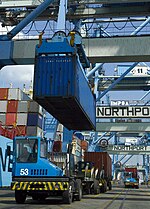Outstaffing
Outstaffing a business practice, "is a way of remote personnel employment, whereby the employee(specialist) is hired by an agency (employer/outstaffing company or contractor) to perform tasks on behalf of the client(out-staffed company)". Unlike outsourcing, this model requires the physical presence of the outstaffing company and the personnel/specialists carries out a minimum of 80% of its tasks from the outstaffing company's premises.
Outstaffing includes foreign and/or domestic contracting. Although very similar to offshoring (relocating a business function to a distant country) or nearshoring (transferring a business process to a nearby country), it shouldn't be confused with any of the latter. However, they can be distinguished as such: a company can out-staff (work with a service provider) and not offshore to a distant country. For example, Apple’s relationship with Chinese manufacturing firm Foxconn is well known, but it does not involve offshoring. In this case, Foxconn is the Outstaffing company while Apple is the client or out-staffed company. In this model, the Outstaffing company is responsible for all issues connected with official employment (taxes, bonuses, equipment, rent etc.).
Thinking critically, Outstaffing and Outsourcing might be a solution to various worldwide economic related problems such as immigration and unemployment in developing countries.
Overview[edit]
Reasons for outstaffing[edit]
Implications[edit]
Advantages[edit]
A solution for developing countries[edit]
Difference between Outstaffing and Outsourcing[edit]
Notes and References[edit]
This article "Outstaffing" is from Wikipedia. The list of its authors can be seen in its historical and/or the page Edithistory:Outstaffing. Articles copied from Draft Namespace on Wikipedia could be seen on the Draft Namespace of Wikipedia and not main one.

